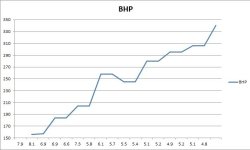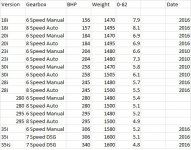A
Anonymous
Guest
There was a post requesting a prediction on the impact of a remap on the acceleration times.
Also there was a debate of the impact / how a gearbox affected acceleration.
This data is the last/latest published by BMW for the various models from the most recent European Spec E89 brochures.
I've then used the 'real world calculator' that mcbutler found https://www.carspecs.us/calculator/0-60 and used it to both re-calculate the BMW official numbers based on their declared masses and flywheel BHP to cross check them.
Whilst not a perfect fit, the more powerful/heavier the car the closer the fit..to within 0.1 of a second in many cases.
The figures shown are the BMW official numbers except for the 280/295 which are predictions, which lie in the part of the graph with the highest degree of correlation.
The calculator is not based on pure maths but calls on a database of published data which it integrates in some fashion.
Of course its only one figure, it would be great if the manufacturers provided 0-100mph / standing 1/4 etc
A few observations:
1) The shift from 2-3 for many Zs occurs around the 60 mph mark..in general the autoboxes have to shift 3 gears to a manual's 2 in most cases. An extra shift either a manual or slower auto box has a bigger impact.
2) We don't know the methodology used by BMW and whether that's consistent over time. For eaxmple..did they just max out in a lower gear to avoid a time wasting shift if the 0-62 was their only goal.
3) The only standardised data available is the limited 0-60 0-62 figures from BMW, there are many figures from many sources but they don't cover enough models to be used as basis of prediction
4) I've calculated a figure for a 280 and 295 BHP remap as various suppliers claim various outputs.
5) At 50 mph a car only needs about 10bhp to overcome drag, so these figures are mostly driven by mass, bhp, torque, initial launch and time to change gear. Drag and rolliing resistance aren't major factors at this end of the speed range and probably relatively similar.
Version Gearbox BHP Weight 0-62 Date
18i 6 Speed Manual 156 1470 7.9 2016
18i 8 Speed Auto 157 1495 8.1 2016
20i 6 Speed Manual 184 1470 6.9 2016
20i 8 Speed Auto 184 1495 6.9 2016
23i 6 Speed Manual 204 1480 6.6 2010
23i 6 Speed Auto 204 1480 7.3 2010
30i 6 Speed Manual 258 1470 5.8 2010
30i 6 Speed Auto 258 1505 6.1 2010
28i 6 Speed Manual 245 1480 5.7 2016
28i 8 Speed Auto 245 1500 5.5 2016
280 6 Speed Manual 280 1480 5.4
280 8 Speed Auto 280 1500 5.1
295 6 Speed Manual 295 1480 5.2
295 8 Speed Auto 295 1500 4.9
35i 6 Speed Manual 306 1580 5.2 2016
35i 7 Speed DSG 306 1600 5.1 2016
35is 7 Speed DSG 340 1600 4.8 2016
I'm sure there will be plenty of analysis..
Also there was a debate of the impact / how a gearbox affected acceleration.
This data is the last/latest published by BMW for the various models from the most recent European Spec E89 brochures.
I've then used the 'real world calculator' that mcbutler found https://www.carspecs.us/calculator/0-60 and used it to both re-calculate the BMW official numbers based on their declared masses and flywheel BHP to cross check them.
Whilst not a perfect fit, the more powerful/heavier the car the closer the fit..to within 0.1 of a second in many cases.
The figures shown are the BMW official numbers except for the 280/295 which are predictions, which lie in the part of the graph with the highest degree of correlation.
The calculator is not based on pure maths but calls on a database of published data which it integrates in some fashion.
Of course its only one figure, it would be great if the manufacturers provided 0-100mph / standing 1/4 etc
A few observations:
1) The shift from 2-3 for many Zs occurs around the 60 mph mark..in general the autoboxes have to shift 3 gears to a manual's 2 in most cases. An extra shift either a manual or slower auto box has a bigger impact.
2) We don't know the methodology used by BMW and whether that's consistent over time. For eaxmple..did they just max out in a lower gear to avoid a time wasting shift if the 0-62 was their only goal.
3) The only standardised data available is the limited 0-60 0-62 figures from BMW, there are many figures from many sources but they don't cover enough models to be used as basis of prediction
4) I've calculated a figure for a 280 and 295 BHP remap as various suppliers claim various outputs.
5) At 50 mph a car only needs about 10bhp to overcome drag, so these figures are mostly driven by mass, bhp, torque, initial launch and time to change gear. Drag and rolliing resistance aren't major factors at this end of the speed range and probably relatively similar.
Version Gearbox BHP Weight 0-62 Date
18i 6 Speed Manual 156 1470 7.9 2016
18i 8 Speed Auto 157 1495 8.1 2016
20i 6 Speed Manual 184 1470 6.9 2016
20i 8 Speed Auto 184 1495 6.9 2016
23i 6 Speed Manual 204 1480 6.6 2010
23i 6 Speed Auto 204 1480 7.3 2010
30i 6 Speed Manual 258 1470 5.8 2010
30i 6 Speed Auto 258 1505 6.1 2010
28i 6 Speed Manual 245 1480 5.7 2016
28i 8 Speed Auto 245 1500 5.5 2016
280 6 Speed Manual 280 1480 5.4
280 8 Speed Auto 280 1500 5.1
295 6 Speed Manual 295 1480 5.2
295 8 Speed Auto 295 1500 4.9
35i 6 Speed Manual 306 1580 5.2 2016
35i 7 Speed DSG 306 1600 5.1 2016
35is 7 Speed DSG 340 1600 4.8 2016
I'm sure there will be plenty of analysis..

